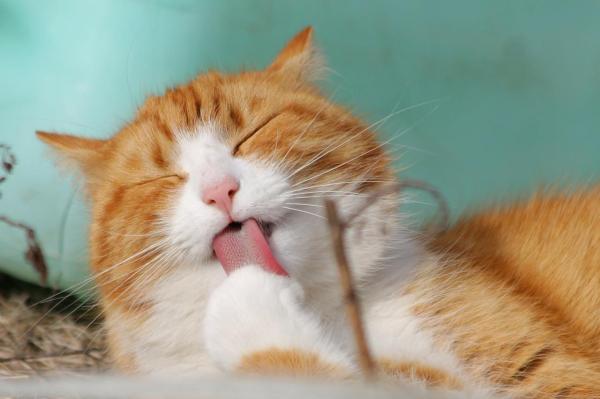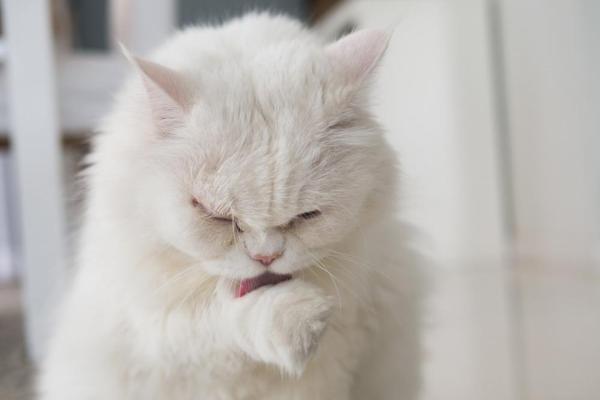My Cat Is Overgrooming - Causes and Treatment



See files for Cats
If your cat is overgrooming, it can be a result of physical, psychological or environmental problems in your cat's life. To understand the causes and treatment of excessive grooming in cats, we need to look at the context of their behavior. If they have started to overgroom all of a sudden, it will likely have a different cause than a slow increase in grooming behavior until it becomes excessive. We may also see there are changes in the home which might affect the cat's behavior, including overgrooming.
At AnimalWised, we explain why my cat is overgrooming. We look at the causes and treatment of excessive grooming in cats. We discover what we can do to stop this occurring in the future, as well as the importance of healthy grooming in cats.
Why do cats groom?
Overgrooming in cats refers to a compulsive and excessive grooming behavior that goes beyond normal grooming habits. Grooming is a natural and essential behavior in cats, serving various purposes. This includes maintaining a clean and healthy coat, regulating body temperature and establishing social bonds. Cats are meticulous groomers and spend a significant amount of time grooming themselves and other cats in their social group.
Importance of Grooming in Cats
Grooming plays a vital role in a cat's life for several reasons:
- Hygiene: grooming helps cats keep their fur clean by removing dirt, debris, and excess oils. This contributes to their overall hygiene and cleanliness.
- Temperature regulation: grooming helps spread saliva across the fur, which, when evaporated, assists in cooling the cat during hot weather. Conversely, during colder temperatures, grooming helps to trap air in the fur, providing additional insulation.
- Stress reduction: regular grooming has a soothing and calming effect on cats. It helps them relax and reduces stress and anxiety.
- Social bonding: grooming is an important social behavior in cats. Cats in the same social group groom each other as a way to strengthen bonds and show affection. For domestic cats, this can help improve the bond between cat and guardian.
What constitutes overgrooming in cats?
As we have stated, grooming is important for cats for various reasons. If they stop doing it, it will lead to various health problems. Their coat will lose conditioning, they can be prone to bacterial infections and they are more likely to develop parasitical infestation. It can lower their immune system and indicate stress. If your cat stops grooming themselves, it can seriously threaten their health and wellbeing.
Conversely, overgrooming can also lead to various problems. This can include the cat losing patches of fur, as well as even causing wounds to appear on the skin. However, it is the underlying cause of the overgrooming which needs to be determined if we want to stop them from harming themselves.

Symptoms of overgrooming in cats
While grooming is essential, overgrooming becomes a concern when it becomes excessive and compulsive. Overgrooming is characterized by the following signs:
- Bald patches: cats may groom so frequently and intensely that they create bald patches on their fur, especially in specific areas like the abdomen, flanks, inner thighs, or the base of the tail.
- Redness and irritation: the constant licking, chewing, or biting of the fur can cause the skin to become red, inflamed, or irritated.
- Compulsive behavior: overgrooming becomes compulsive when the cat engages in the behavior excessively, to the point where it interferes with normal activities such as eating, playing, or interacting with other cats or humans.
- Hairballs and digestive issues: excessive grooming can lead to the ingestion of excessive fur, resulting in hairballs or digestive problems.
- Lack of improvement: overgrooming persists even if there are no apparent underlying medical issues.
Overgrooming can have various underlying causes, including stress, anxiety, boredom, pain, allergies or medical conditions. Identifying the specific cause is crucial to addressing the behavior effectively.
Causes of overgrooming in cats
Overgrooming in cats can have various causes, which can be classified into psychological, physiological, and environmental factors:
Psychological causes
- Stress and anxiety: cats may overgroom as a response to stress, anxiety, or changes in their environment. Overgrooming can serve as a coping mechanism or a way to self-soothe when they feel anxious or overwhelmed. Discover more about the reasons why a cat is stressed.
- Boredom or frustration: cats that lack mental and physical stimulation may engage in excessive grooming as a means to release pent-up energy or frustration.
- Compulsive behavior: overgrooming can become a compulsive behavior in some cats. Compulsive disorders may arise due to genetic predisposition, previous traumatic experiences, or other underlying factors.
Physiological causes
- Pain or discomfort: cats in pain or discomfort may overgroom as a response to the physical discomfort they are experiencing. Overgrooming may focus on specific areas that are causing discomfort. The source of the pain may be due to a traumatic wound, but it can be due to anything which causes irritation to the skin. This can include burns, parasitical infestations or even skin tumors.
- Skin allergies: allergies to certain foods or environmental factors can trigger itching and discomfort, leading to excessive grooming in an attempt to alleviate the irritation. Find out about other symptoms of skin allergies in cats.
Environmental causes
- Environmental changes: changes in the cat's living environment, such as moving to a new home or the introduction of a new pet, can cause stress and trigger overgrooming.
- Social factors: cats that experience conflicts or changes in their social group dynamics may resort to overgrooming as a way to cope with social stress.
- Lack of resources: insufficient access to resources such as food, water, litter boxes, or resting spots can lead to stress and contribute to overgrooming.
- Boredom or isolation: cats left alone for extended periods or without opportunities for interaction and play may develop overgrooming behavior as a response to boredom or isolation.
- Seasonal changes: some cats may experience overgrooming during seasonal changes, which can be related to temperature shifts or daylight variations.
It's important to note that overgrooming may have a combination of factors contributing to the behavior. Identifying the specific cause or triggers for each individual cat can be complex and may require the expertise of a veterinarian or a veterinary behaviorist to accurately assess and address the underlying issues.

How to stop a cat overgrooming
To address overgrooming in cats, identifying and addressing the underlying causes is crucial. Since excessive grooming can have various psychological, physiological and environmental triggers, the approach to stopping overgrooming may involve the following:
- Veterinary examination: a thorough veterinary examination is essential to rule out any underlying medical conditions that may be contributing to the overgrooming behavior. Skin allergies, infections, or pain issues should be identified and treated accordingly.
- Behavioral assessment: in cases where psychological factors are involved, a behavioral assessment by a veterinarian or veterinary behaviorist can help determine if stress, anxiety, or compulsive behaviors are contributing to the overgrooming.
- Environmental enrichment: providing a stimulating and enriching environment is crucial for preventing boredom and stress-related behaviors. Interactive toys, scratching posts, climbing structures, and daily playtime can help alleviate stress and reduce overgrooming.
- Reducing stress: if stress is identified as a trigger, steps should be taken to reduce stressors in the cat's environment. This may include providing hiding spots, separate feeding areas, and quiet spaces for the cat to retreat to.
- Behavior modification: behavior modification techniques, such as positive reinforcement training and desensitization, can be used to address compulsive behaviors and redirect the cat's attention away from overgrooming.
- Medication: in some cases of severe anxiety or compulsive behaviors, medication may be prescribed by a veterinarian to help manage the underlying psychological issues.
- Allergen management: if allergies are causing discomfort and triggering overgrooming, identifying and managing allergens, such as changing the diet or removing potential environmental triggers, may be necessary.
- Hormonal therapies: in certain cases where overgrooming is related to hormonal imbalances, hormonal therapies prescribed by a veterinarian may help regulate the cat's behavior.
- Anti-inflammatory treatment: for cases where overgrooming is due to pain or discomfort, anti-inflammatory medications may be prescribed to relieve the underlying condition.
It's essential to note that each cat is unique. The approach to stopping overgrooming will vary depending on the individual cat's needs and underlying causes. A comprehensive and tailored treatment plan, involving a combination of approaches, may be necessary for successful resolution of the overgrooming behavior. Consulting with a veterinarian or veterinary behaviorist is crucial for accurate diagnosis and the development of an effective treatment plan for the cat's wellbeing.
This article is purely informative. AnimalWised does not have the authority to prescribe any veterinary treatment or create a diagnosis. We invite you to take your pet to the veterinarian if they are suffering from any condition or pain.
If you want to read similar articles to My Cat Is Overgrooming - Causes and Treatment, we recommend you visit our Other health problems category.








